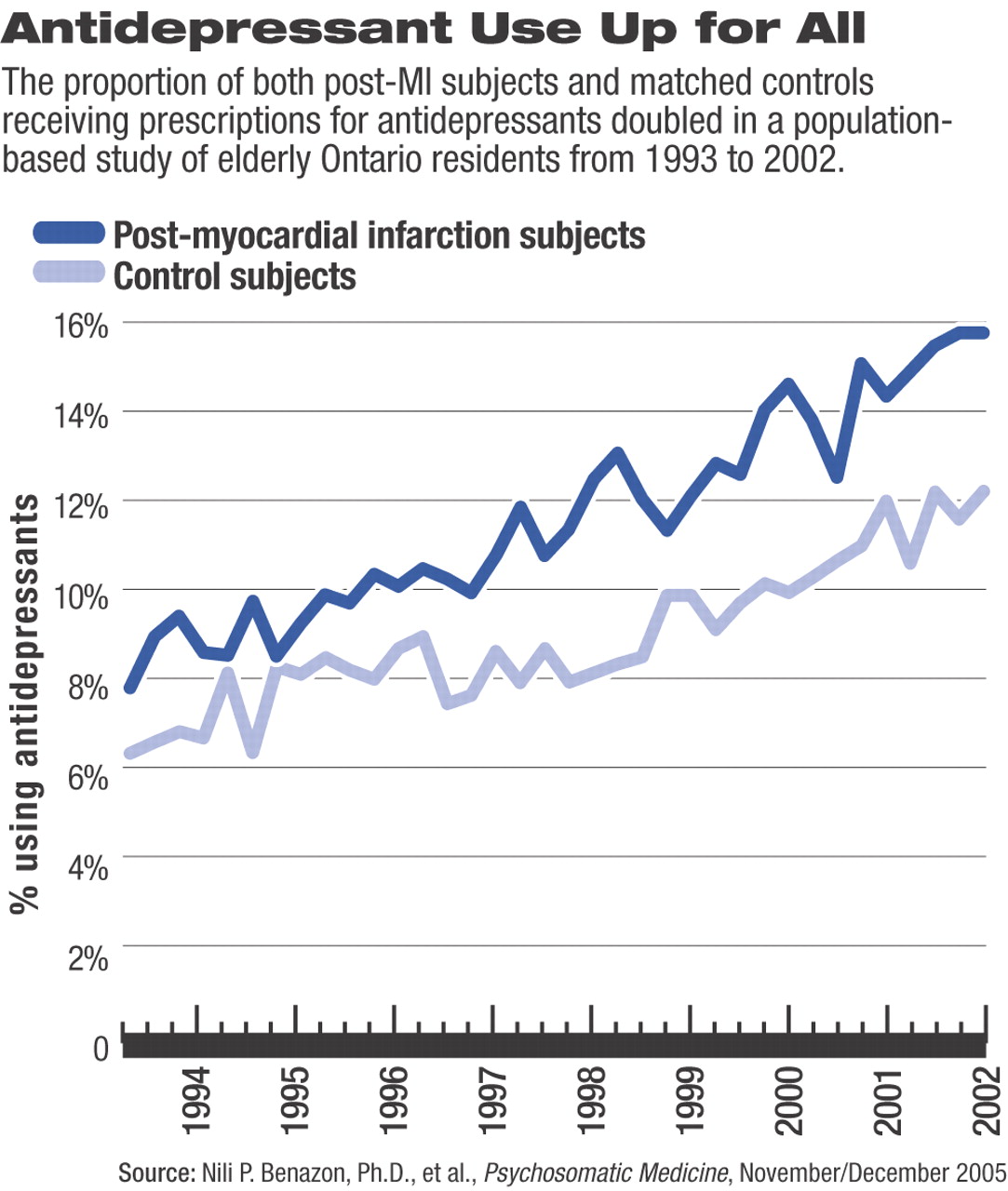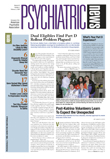Heart attack victims in Ontario were twice as likely to be treated with antidepressants in 2002 as they were in 1993, but so was a group of matched controls, a pattern reflecting general population trends rather than an increased concern about depression in cardiac patients, according to a study of more than 137,000 elderly Ontario residents.
Moreover, although the use of selective serotonin uptake inhibitors (SSRIs) increased as a percentage of prescriptions, the percentage of patients taking tricyclic antidepressants (TCAs) remained the same.
“Despite the higher rates of SSRI prescribing on a population basis, we don't see that evidence demonstrating a strong connection between depression and reinfarcts and deaths among MI patients is yet translating into clinical practice,” said lead author Nili Benazon, Ph.D., of the Centre for Addiction and Mental Health and the Sunnybrook and Women's Health Sciences Centre in Toronto, in an interview with Psychiatric News.
Prior epidemiological research has found a strong association between depression and heart disease, but the issue of causality remains unconfirmed by prospective studies (Psychiatric News, August 5, 2005).
Benazon and her colleagues, Muhammad Mamdani, Pharm.D., of Toronto's Institute of Clinical Evaluative Sciences, and James Coyne, Ph.D., of the University of Pennsylvania Health System in Philadelphia, drew on four databases for the study: provincial prescription claims, health insurance, and a population registry, as well as the Canadian Institutes of Health Information's hospital discharge abstract database. The study was published in the November-December 2005 Psychosomatic Medicine.
The researchers identified 68,870 patients who had had heart attacks and an equal number of age- and sex-matched controls. Antidepresssants in the study included tricyclic and heterocyclic antidepressants, monoamine oxidase inhibitors, and SSRIs.
The percentage of heart attack patients getting antidepressants edged upward consistently over the study period, going from 7.8 percent (n=128 of 1,637 subjects) in 1993 to 15.7 percent (350/2,231) in 2002, and in matched control patients who had not had a heart attack, increasing from 6.4 percent (105/1,637) to 12.2 percent (273/2,231).
The initial results of the study showed that post-MI patients were more likely than controls to be prescribed an antidepressant (odds ratio=1.34). However, adjusting for the number of prescriptions for any medications paradoxically shifted that relationship, so that those who had had heart attacks were actually less likely to receive antidepressants than matched controls (odds ratio=0.81).
Why would having more prescriptions reduce the chances of being prescribed an antidepressant?
Drawing on previous research by others, Benazon and colleagues suggested that the total number of prescriptions reflects medical comorbidity or physician visits, and that management of a chronic disease interferes with treatment of unrelated conditions.
“It is therefore plausible that the likelihood that an elderly post-MI patient will receive a prescription for an antidepressant increases with the number of medical visits, but the competing demands of managing the cardiac condition decrease the likelihood that antidepressants will be prescribed in a given visit,” they wrote. “Health care following an MI might thus be characterized by more visits but less likelihood of a prescription for an antidepressant in any given visit, yielding the contrast between higher unadjusted odds of receiving an antidepressant and lower adjusted odds.”
In short, patients who had heart attacks were prescribed more medications but relatively fewer of those prescriptions were for antidepressants.
The study results also reflected the increasing availability and use of SSRIs. In 1993, 23 percent of all antidepressant prescriptions for post-MI patients were for SSRIs, rising to 62 percent in 2002. Prescriptions for TCAs fell over the same time, from 83 percent to 36 percent. (A small number of patients received heterocyclic antidepressants or monoamine oxidase inhibitors.)
Despite this general reversal in percentage of prescriptions, there was no corresponding drop in the percentage of patients prescribed TCAs. Six percent of post-MI patients and 5 percent of controls got TCAs in 1993, figures that were unchanged in 2002 and left the researchers puzzled.
“That there has been no reduction in the proportion of patients receiving TCAs over the last decade suggests that there is a problem in continued prescription for depression, and presumably at cardiotoxic dosages, but we cannot establish the magnitude of the problem,” the authors noted.
“The difficulty in unambiguously interpreting the TCA data is that some represent low dosage for pain and sleep,” added Benazon.“ Also, our first observations in this dataset were from a decade earlier, when there was less evidence about toxicity and fewer alternatives to treat depression.”
“I would agree that SSRIs are safer, but that information may not be well known to physicians unless it's publicized or included in guidelines,” said David Sheps, M.D., editor of Psychosomatic Medicine and a professor of medicine and associate director of the division of cardiovascular medicine at the University of Florida.“ People have a hard time changing their prescribing habits. But at least we see a gradual rise in the percentage of patients getting antidepressants. That's probably a good thing.”
The growing suspicion of excessive and inappropriate prescription of antidepressants, even in the face of persistent under-treatment and inadequate treatment of depression, also concerned the researchers, said Benazon.
She cited unpublished data indicating that at least 25 percent of primary care patients receiving antidepressants for depression had never experienced two consecutive weeks of mood disturbance.
The bulk of treatment with antidepressants occurs in general medical rather than specialty mental health care, and only 20 percent to 30 percent of patients receiving treatment for depression in general medical care obtain adequate care, she said.
“Questions of the specificity and adequacy of treatment being provided for depression are important in evaluating the progressive increase in the prescription of antidepressants to post-MI patients and elderly patients more generally, but answering these questions requires going beyond the data available in our integrated dataset.”
“Trends in the Prescribing of Antidepressants Following Acute Myocardial Infarction, 1993-2002” is posted at<www.psychosomaticmedicine.org/cgi/content/full/67/6/916>.▪
Psychosom Med 2005 67 916

